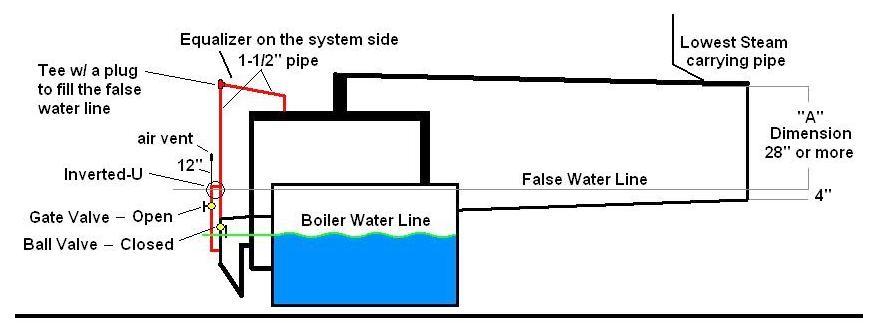Welcome! Here are the website rules, as well as some tips for using this forum.
Need to contact us? Visit https://heatinghelp.com/contact-us/.
Click here to Find a Contractor in your area.
If our community has helped you, please consider making a contribution to support this website. Thanks!
False Water Line Equalizer pipe size?
Options

ProblemSolver
Member Posts: 190
The return pipe is 1&1/2 inch, the false water line / inverted - U is being built with 1&1/2 inch pipe. There is no mention in the book about the Equalizer pipe size, so I have laid it out for 1&1/2 inch keeping it all one size pipe and fittings. Is there a need for a larger or smaller equalizer pipe?
- the drawing is my layout so I can see what I will need to pipe this false water line. Any other suggestions is greatly welcomed. One more thing: the 4 feet of pipe on the inverted "U" seal; is that 4 feet of pipe above the horizontal return pipe? Or, 4 feet above the mud pipe?
-
- the drawing is my layout so I can see what I will need to pipe this false water line. Any other suggestions is greatly welcomed. One more thing: the 4 feet of pipe on the inverted "U" seal; is that 4 feet of pipe above the horizontal return pipe? Or, 4 feet above the mud pipe?
-

0
Comments
-
Inch and a half should work just fine. Technically, since there should be no flow, you could go smaller if need be, but I don't see a good reason to.
I'm not just sure to what location you are referring with that 4 feet of pipe...Br. Jamie, osb
Building superintendent/caretaker, 7200 sq. ft. historic house museum with dependencies in New England0 -
In the book, "lost art of steam heating", page 29, 4th paragraph, "if you can get about four feet of rise on your inverted "U" seal and still have the 28" to your lowest horizontal steam - carrying pipe your'll usually be in good shape."
- What purpose is the 4 feet serving? And where does it begin?0 -
Ah. That's from the bottom of the seal -- the old wet return before it goes up to the Hartford loop. It's good if you can get that much height -- but if it's less (so long as it's not a lt less) you should be OK.Br. Jamie, osb
Building superintendent/caretaker, 7200 sq. ft. historic house museum with dependencies in New England1 -
I call that the "mud pipe". I purposely pipe that as low as I can to help trap mud there, and keep it out of the boiler. Thanks Jamie Hall; much appreciated.0
-
I don't understand what the air vent down that low is going to do or how it would even work. Doesn't seem right to me.0
-
To get the initial air out of the false water line piping. With out the vent, the steam will not move past the end of the main header, at the boiler, on start-up and into the false water line piping. As condensate builds up at the drip, at the end of the steam main, the condensation won't flow into the air-bound false water line, instead it will back-up into the main steam line and you'll get water hammer.0
Categories
- All Categories
- 87.3K THE MAIN WALL
- 3.2K A-C, Heat Pumps & Refrigeration
- 61 Biomass
- 427 Carbon Monoxide Awareness
- 119 Chimneys & Flues
- 2.1K Domestic Hot Water
- 5.8K Gas Heating
- 114 Geothermal
- 165 Indoor-Air Quality
- 3.7K Oil Heating
- 76 Pipe Deterioration
- 1K Plumbing
- 6.5K Radiant Heating
- 395 Solar
- 15.6K Strictly Steam
- 3.4K Thermostats and Controls
- 56 Water Quality
- 51 Industry Classes
- 50 Job Opportunities
- 18 Recall Announcements
